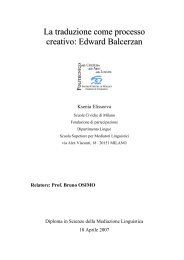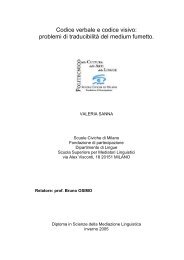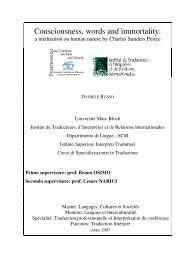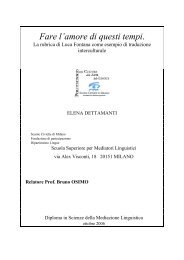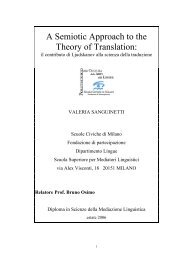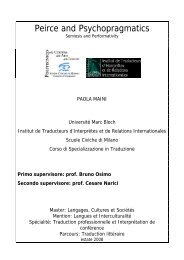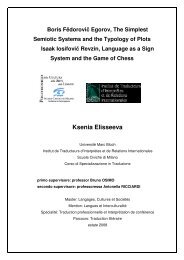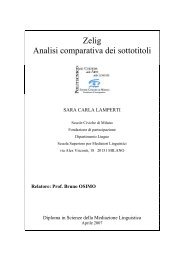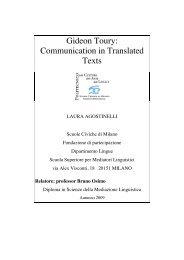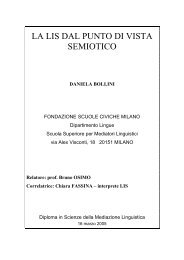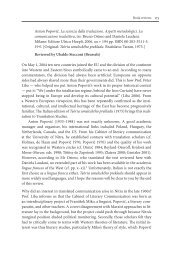Alice in Wonderland - Bruno Osimo, traduzioni, semiotica della ...
Alice in Wonderland - Bruno Osimo, traduzioni, semiotica della ...
Alice in Wonderland - Bruno Osimo, traduzioni, semiotica della ...
Create successful ePaper yourself
Turn your PDF publications into a flip-book with our unique Google optimized e-Paper software.
4. The translation of proper names <strong>in</strong> <strong>Alice</strong> <strong>in</strong> <strong>Wonderland</strong><br />
As is well known, Lewis Carroll, alias Charles Dodgson, wrote <strong>Alice</strong> <strong>in</strong><br />
<strong>Wonderland</strong> <strong>in</strong> 1862 for his little friend <strong>Alice</strong> Liddell, 10, and her two sisters<br />
Lor<strong>in</strong>a Charlotte, 13, and Edith Liddell, 8 years old. Certa<strong>in</strong> characters or<br />
figures of the story are explicitly or implicitly taken from the girls’ real<br />
situation, and we may assume that this must have amused them very much.<br />
Others are pure fiction.<br />
In <strong>Alice</strong> <strong>in</strong> <strong>Wonderland</strong>, we f<strong>in</strong>d the follow<strong>in</strong>g forms of proper names:<br />
a. names explicitly referr<strong>in</strong>g to the real world of author and orig<strong>in</strong>al<br />
addressees,<br />
b. names implicitly allud<strong>in</strong>g to the real world of author and orig<strong>in</strong>al<br />
addressees by means of wordplay,<br />
c. names referr<strong>in</strong>g to fictitious characters.<br />
4.1. Proper names referr<strong>in</strong>g to the real world of author and<br />
orig<strong>in</strong>al addressees<br />
The “real” world is England <strong>in</strong> the second half of the 19th century, <strong>in</strong>clud<strong>in</strong>g<br />
historical facts presupposed to be known by the first addressees of the story,<br />
namely <strong>Alice</strong> Liddell and her sisters. Apart from the first addressees A1, as<br />
soon as it is published, the book is directed at a broader audience A2,<br />
namely children and/or adults, probably shar<strong>in</strong>g the same real-world<br />
knowledge. The names explicitly referr<strong>in</strong>g to the real world of author and A1<br />
can be assumed to fulfil their identify<strong>in</strong>g function also for A2.<br />
In the story or <strong>in</strong> the poems quoted <strong>in</strong> the story, we f<strong>in</strong>d several<br />
names of persons belong<strong>in</strong>g to the “real world” of the author and the<br />
audience A1 (<strong>Alice</strong>, her nurse Mary Ann, her school mates Ada and Mabel),<br />
of places (New Zealand, Australia, London, Rome, Paris, the Nile), and<br />
historical personalities (Shakespeare, Edw<strong>in</strong>, the Earl of Mercia, Morcar, the<br />
Earl of Northumbria, Stigand, the Archbishop of Canterbury, Edgar Athel<strong>in</strong>g,<br />
37



